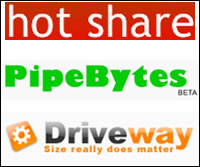Large File Menace: The Way Out
Sending files has never ceased to be a headache to many online users. One of the major hurdles of file transfer is the long time one has to wait for files to be attached to email. Important business deals have flopped due to failure of attachments reaching the intended persons on time. It is also common for one to re-send an email attachment again and again just to be certain that the recipient has received the attachment.
When someone needs to send a large file without using email, one may want to know what services and tools are available at one’s disposal that do not need tech knowledge. One can use the traditional approach of sending email attachments. The disadvantage with this is that it may never reach the recipient for several reasons: First, some Internet providers do not allow large files through. Secondly, if the providers do allow large files, large files tend to hog the recipient's email as they take time to download depending on the file size, the person's Internet connection speed and recipient's host provider.
Another option would be to use Private Peer to Peer (P2P) file sharing tools such as Grouper. P2P file sharing is where multiple computers are able to share resources such as files as equals. This means there is no central server. However, P2P file sharing tools are not as easy to adopt for users needing to send large files on an occasional basis. This is because they need to be downloaded and installed before use. Furthermore, they consume system resources such as the RAM.
 |
| Logos of web based file exchange providers |
To access the service, simply type the web address of the file exchange provider on your browser e.g. for the case of Hotshare one would type the address http://hotshare.net/. Then upload all the files (between 200MB and 500MB each). Once uploaded, a download link will be displayed typically on a text box. An option of entering the email addresses of the recipients will then be made available. One may also choose to share the link via IM (Instant Messaging) to allow friends or work-mates to get the file. One will then receive a “remove file” link with which one can use to remove the file(s) from the online storage in the future.
With Web-based file exchange services, one can share any type of file: music, videos, pictures, zipped files etc. The advantages of these services is that most do not require registration, they are free to use, they give a delivery receipt, they do not have an expiry period meaning one can upload the file and leave it there for as long as one desires. They also allow multiple recipients to access and download a file.
However, most of them do not offer virus scan, compression and encryption. It is therefore more likely that many online users will stick to Yahoo and Google mail to attach large files as they are trusted in terms of security.
